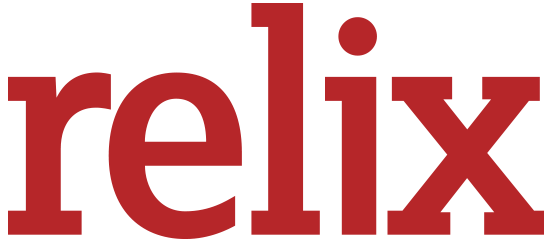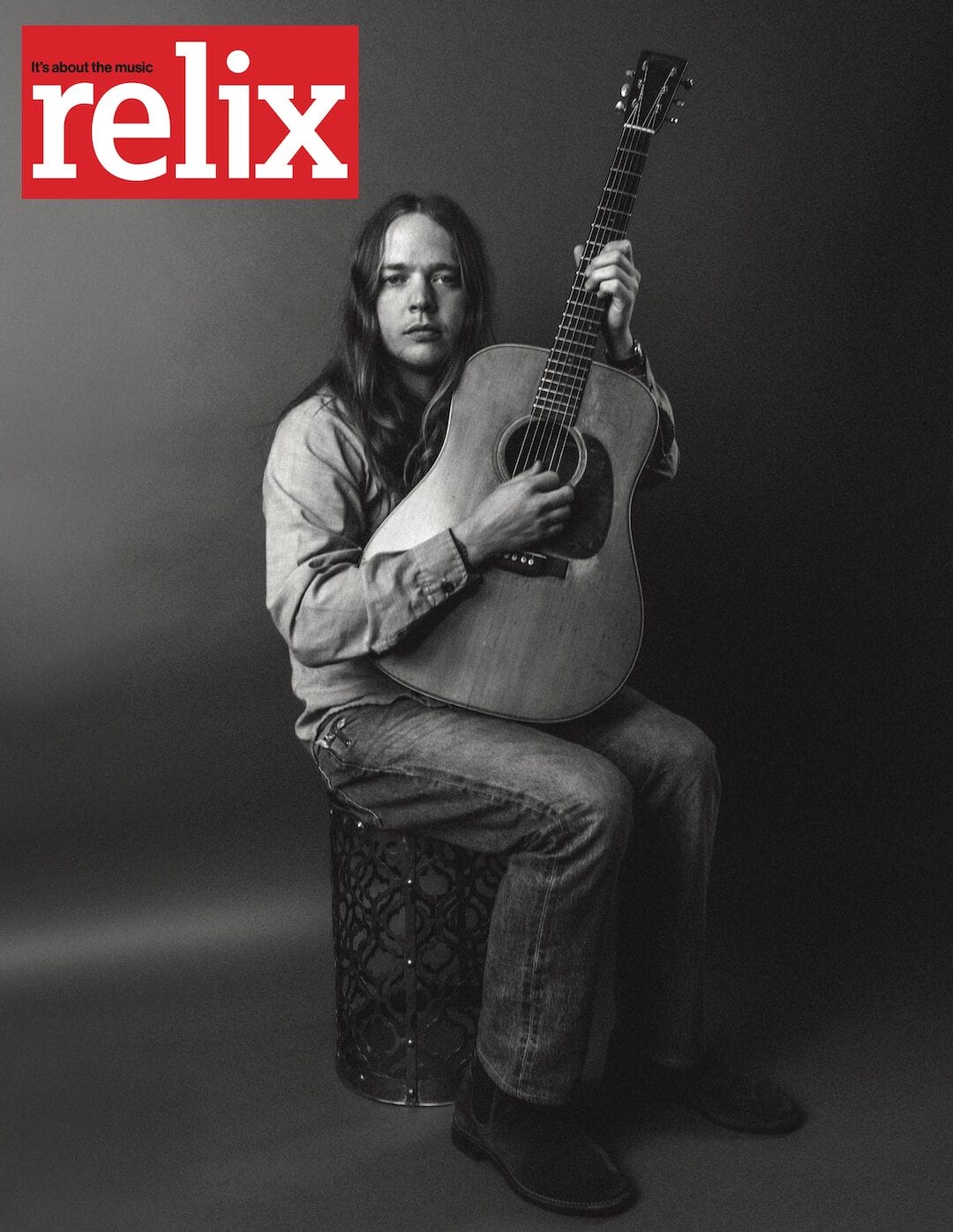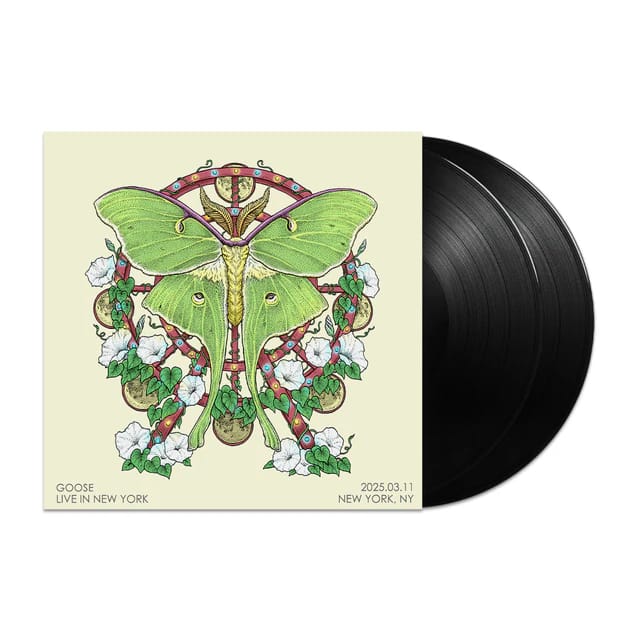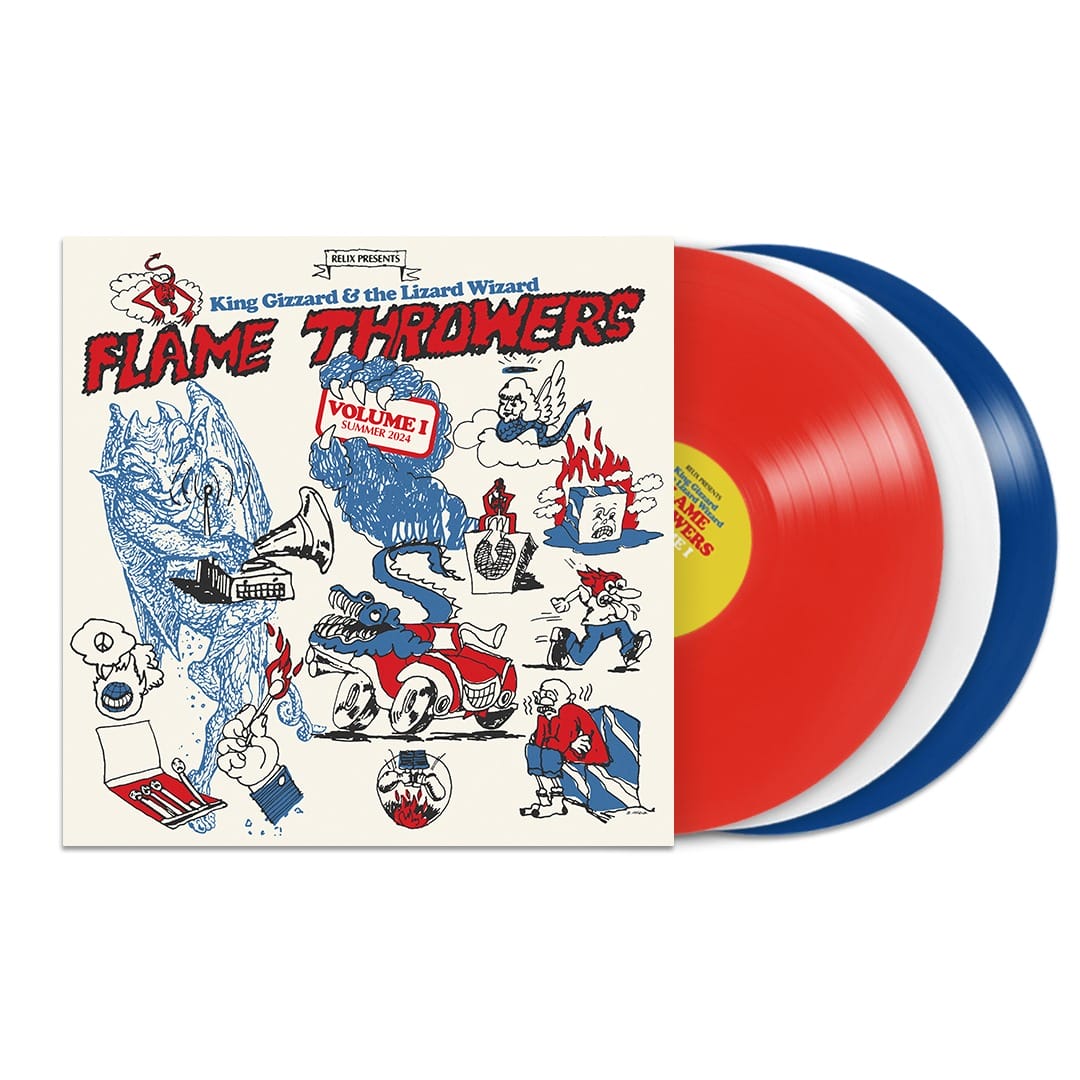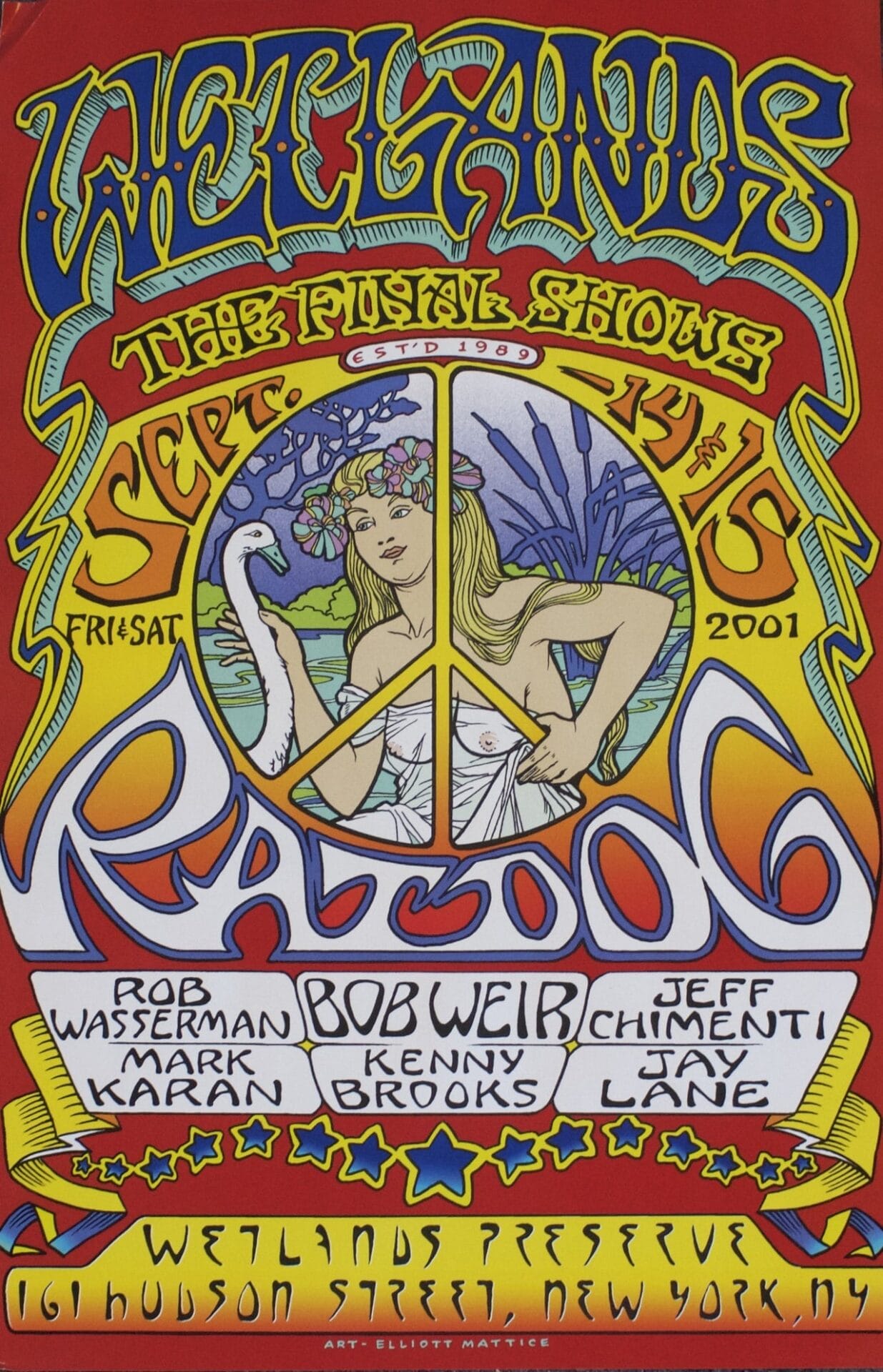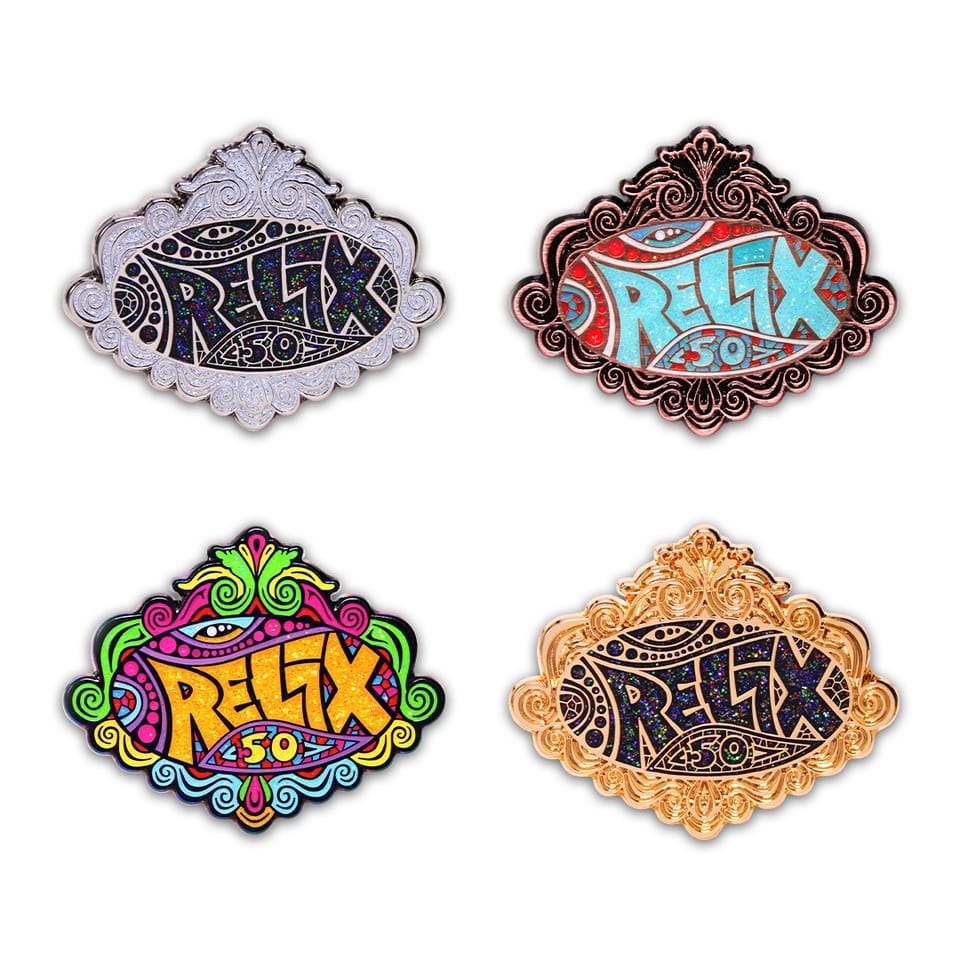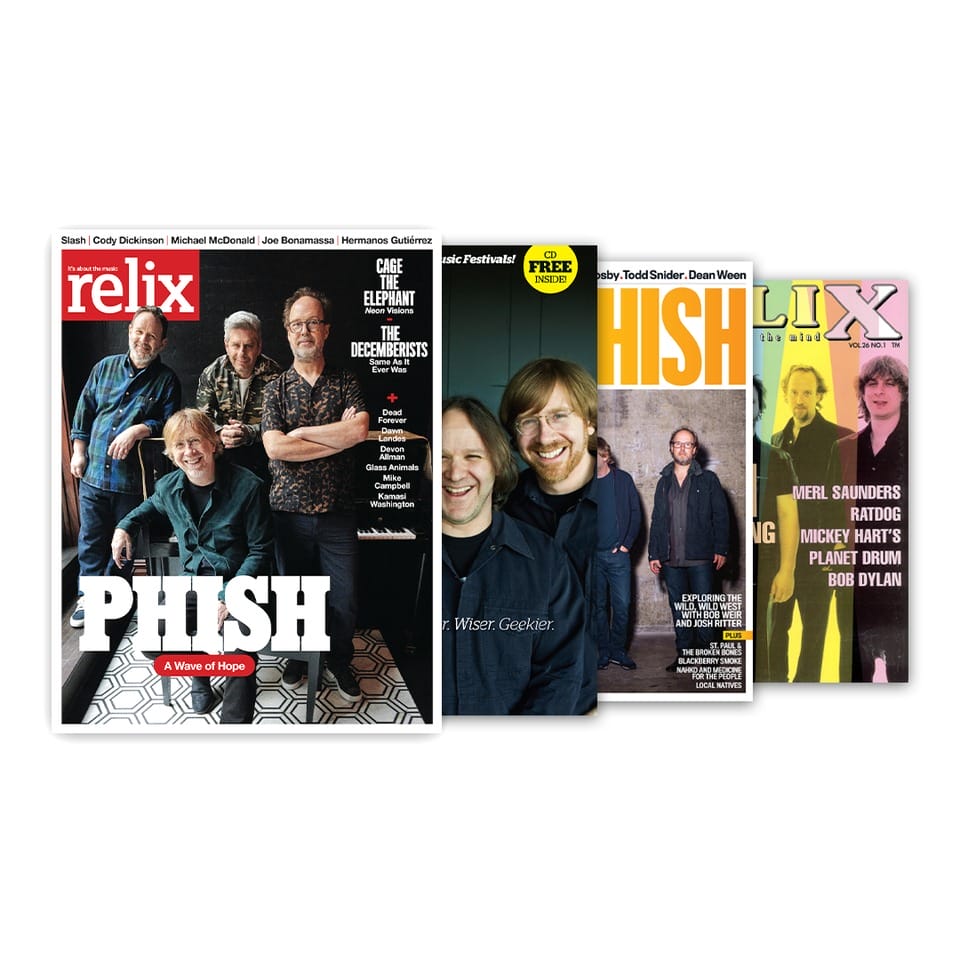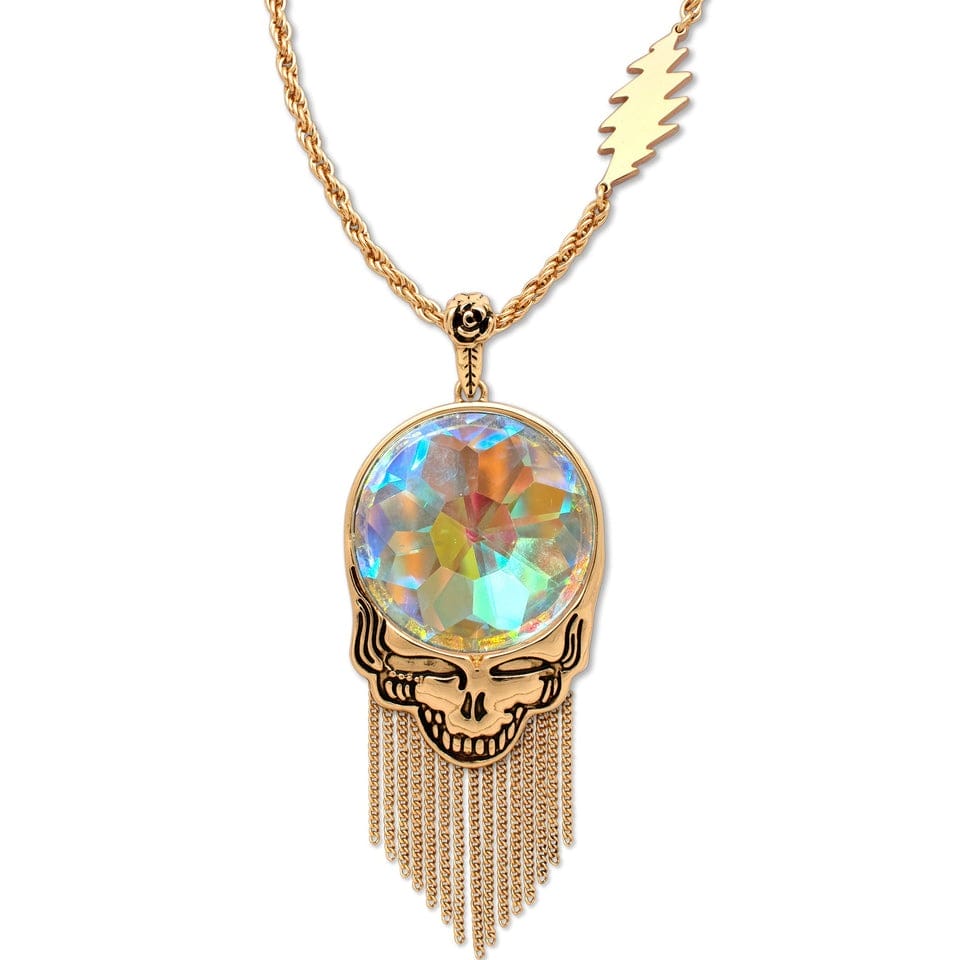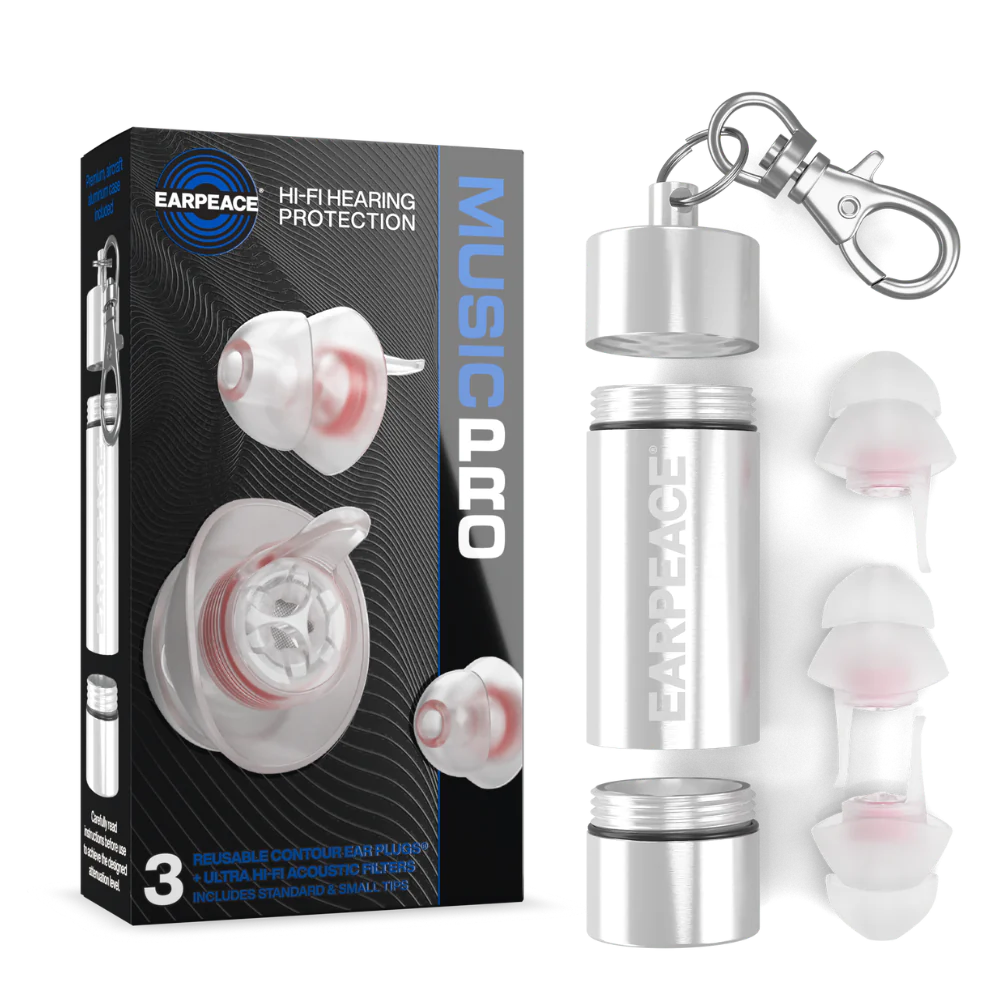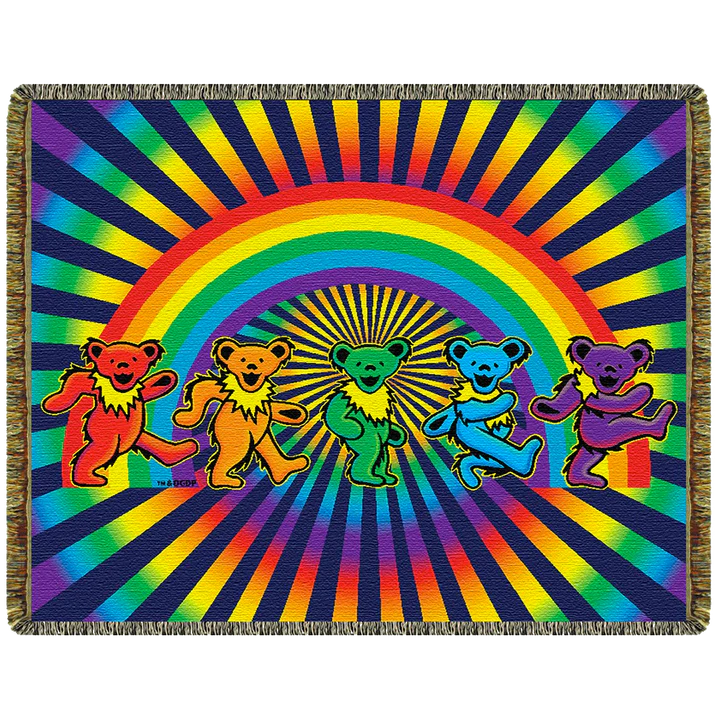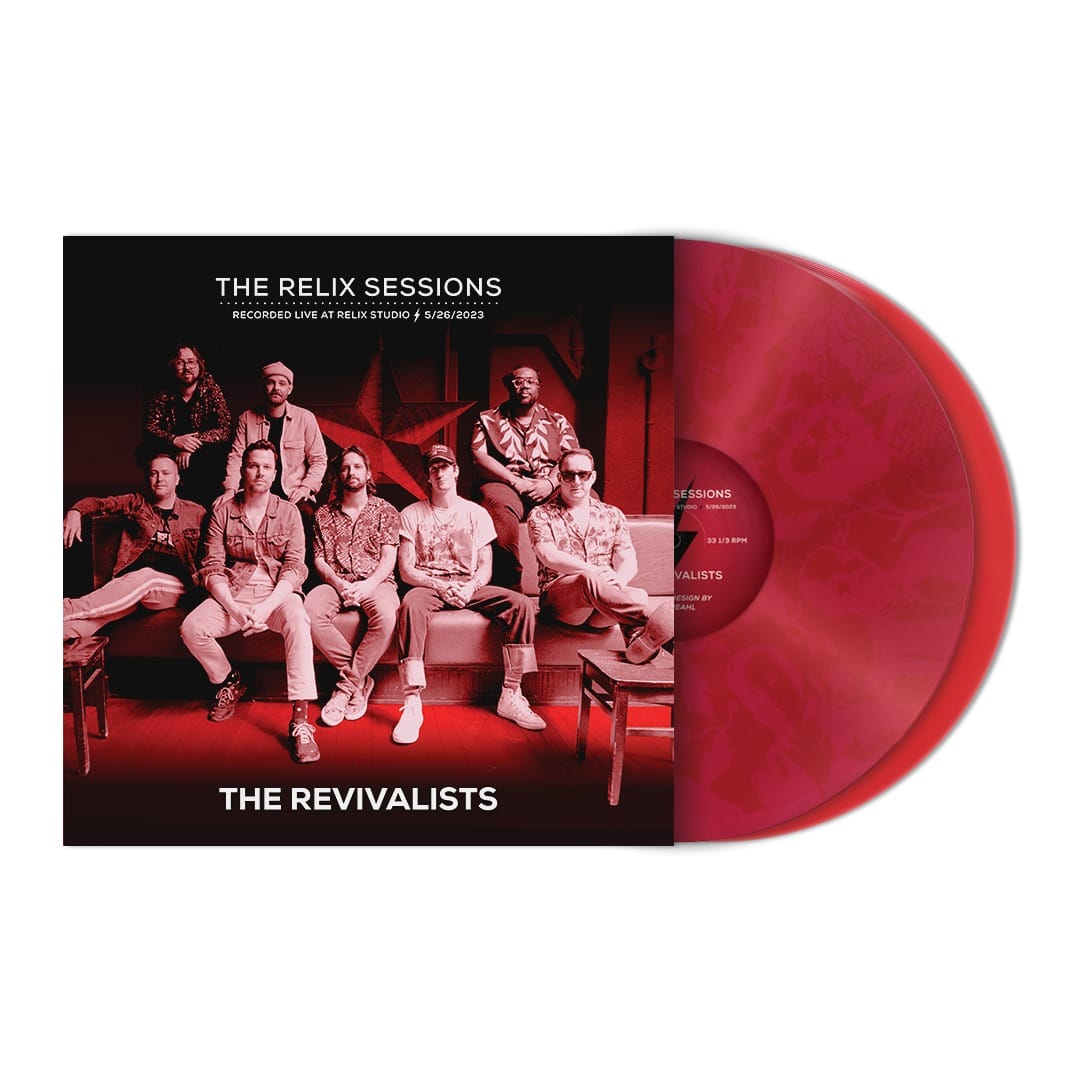Trey Anastasio: Beacon of Hope
photos by Jake Silco
***
“I’ve never been part of anything that felt so miraculous,” proclaims Trey Anastasio. He offers this bold and deeply held declaration while musing on the Beacon Jams, the series of shows that streamed weekly from New York City’s Beacon Theatre in the fall of 2020 during the COVID pandemic. Anastasio appeared each Friday from October 9 through November 27, with an evolving passel of collaborators, performing music that spanned his career. In many instances, he fashioned new arrangements of material he had first played with Phish, Trey Anastasio Band and Ghosts of the Forest, juxtaposed with recent compositions that spoke to the moment.
While the streams were free, viewers were encouraged to make donations to the newly formed Divided Sky Foundation with the goal of raising money to assist people affected by addiction. Ultimately, $1.2 million was donated to the cause, which then funded a treatment center in Ludlow, Vt.
“Over the past few years, I’ve found myself regularly saying I’ve never been part of anything that was so musically and emotionally satisfying,” Anastasio says of the Beacon Jams experience. “It was a highlight of my musical life in ways that are hard to even describe. It was this small miracle and there were so many little unexpected things. Obviously, it was COVID, all five boroughs were shut down and there were no marquees lit. Then this idea came up that we were going to maybe find a black box theater, which would be a little studio to do some streams. From there, it started to take on a life of its own and grow.
“I remember the biggest hurdle was I kept telling anyone who would listen that the streams had to be free and for a cause. We could not ask people to pay in that moment because everyone needed music and community. While at first that seemed impossible, thankfully, it ended up being free [via Twitch]. In addition, the musicians had been out of work, the doormen at the Beacon had been unemployed and the vibe was just unbelievable. I’ve never been part of anything that felt so pure on every level.”
Anastasio then turns his thoughts to the Divided Sky Residential Recovery Program. He remarks, “Just yesterday, I was on a three-hour board meeting for Divided Sky. We have an incredible board now, and I was just sitting there listening to everybody talk. I almost couldn’t believe, not only that the place is open, but also that 97% of the people who graduate say they would recommend it to other people. You’ve got to understand that most people who are first getting sober are pretty miserable, so it’s really heartening to hear that response. There’s also a new women’s scholarship program, which is starting to make a difference.
“It’s up in this bucolic spot. It’s affordable and it’s vibey. The same spirit that went into the Beacon Jams now exists up there at the treatment facility.”
The Beacon Jams weren’t quite concerts, which you acknowledged immediately and eloquently through your stage orientation by facing away from the house. Beyond that though, in terms of your creative approach and the flow of the evening, how long did it take you to feel comfortable with the format?
This is an interesting thing. I’m used to flying in that unknown zone, and I’m comfortable there. For example, I’m now working on our New Year’s event. It can begin nine months in advance, and it often doesn’t get nailed down until 35 minutes before we go on stage. Traditionally, there’s a lot of thinking, forgetting and practicing, even on just a regular old show. So I’m comfortable with that. Similarly with the Beacon Jams, I’m sitting right now in the room in my house where I was writing songs and sending out videos during COVID. It’s the same place where the Beacon Jams were conceived. I started off by speaking to Marc Janowitz, who did the lights. He’s the one who eventually said, “Turn around and face the other direction,” which was like, “Go Marc!” He’s a great lighting designer, who does TAB’s lights along with a lot of other bands, and he had experience with TV.
We got on the phone and I was like, “How would I do this?” He said, “You’d get a black box theater.” But I wasn’t sure how that would work because we couldn’t stand next to each other due to COVID. Then all of a sudden, Madison Square Garden donated the Beacon to us. They wanted to contribute, and we’ve played so many shows at Madison Square Garden—I think at this point it’s 87.
They also said, “We’re going to employ some of our staff while you’re there.” When I think back on what people were facing at that time, it was unbelievable. It makes me cry.
So we got out of the black box theater, we got into the Beacon and then it became, “How long should this thing be?” We were figuring it all out, minute by minute, day by day.
A lot of the musical decisions came in response to the situation, like doing a more orchestral version of “You Enjoy Myself.” I didn’t want to play the beginning of “You Enjoy Myself” in a band format without Jon Fishman. That would be too wacky. So I was like, “OK, I’ll just do a string thing at the beginning.”
We would try something and see how it worked. Then, every single day, I’d wake up and start improving things—“Will this work? Will that work?”
Then, once the thing got going, we were getting direct communication from the audience on the screen. Somebody said, “Play ‘Let Me Lie.’” So I was like, “Oh, you want ‘Let Me Lie?’” I never play ‘Let Me Lie,’ but somebody said it—one person wanted it. So then I went home and I was like, “Oh, I better learn ‘Let Me Lie’ for next week.”
It all became a joyous, continued focus on my part and also this group mind. It was a balancing act. Like I was hanging out with the amazing Jo Lampert, who I just adore. She was there a couple of the weeks, and we were going to do this “You Enjoy Myself” thing with Celisse Henderson and Jennifer [Hartswick]. So I went, “Boy!” and I think it was Jo who said, “Woman!” I was like, “Yeah!” Then I said, “The three of you should come walking in through the fog.” Marc was like, “Oh, I’ve got a fog machine.” So they turned on a fog machine and then they were going to wear leather. It just kept building and building.
The most poignant moments for me were during the last week. We did this song “Just a Touch,” and it was just me, James [Casey], Natalie [Cressman] and Jen singing it with an acoustic guitar. It was a new song. We opened the final week with that and James had come in from Hawaii, which was a tall order. He had to go through COVID protocols to get to the airport. Then he had to quarantine for 14 days, the whole thing. But that group was so close. It was really magical, the friendship and unity of the three of them, and I consider myself to be in that with gratitude and joy.
That week opened with us singing this brand new song, and then we ended the whole thing with “First Tube,” which was the first song I ever wrote with Tony Markellis. The first day that me, Tony and Russ [Lawton] decided we were going to do the 8 Foot Fluorescent Tubes show [in 1998], we got together and wrote “First Tube.”
So the final show at the Beacon opened with James, Natalie, Jen and me singing “Just a Touch,” and it closed with “First Tube.” Then everybody marched out past the dancers onto the street. Tony wasn’t feeling that well and didn’t want to get off his chair, so he didn’t march out. The rest of us marched off the stage, waved goodbye and that was the last time I ever saw Tony. He died a few months later.
It was the last time I ever saw him, and eerily, it was the first song we ever wrote together. We played it, we walked off stage, he didn’t walk with us and I never saw him again. Also eerily, about two days before he passed away, we got on the phone together and talked for a few hours. I don’t think I ever talked to Tony for that long on the phone. We had a beautiful conversation and I never spoke to him again.
Then James, as we know, also passed away [in 2023, after a protracted battle with colon cancer]. So watching that week is really kind of hard for me, but also poignant in that James was there and Tony was there. It was the end of something as well.
It’s very emotional, the whole thing. I’ll say it again, but I really mean this—I’ve never been part of anything that felt so pure, and it just unfolded like a dream.
It also sounded great, thanks to Garry [Brown], who was down in the basement due to COVID. Trey Kerr, who did the video, crushed it. I talk to him about it all the time. When he does the livestreams for Phish, if you go in his little office, the walls are covered with pictures of the Beacon Jams. Marc Janowitz absolutely crushed it as well.
I think everybody remembered what the point was. It was like, “Oh, my God, people are at home. They’re going to see this. They’re stuck. We’re helping them.” In the process, we also felt like we were helping ourselves.
The expanded version of the Rescue Squad string section from that November 6 show were the top, first-seat string players on Broadway. They were out of work because Broadway was decimated by COVID, so when they got the call, they were psyched. Orchestras and Broadway got destroyed by COVID. Broadway still hasn’t totally come back since COVID, unfortunately. There are something like 92,000 employees on Broadway. It’s a huge part of New York, way bigger than most people know, because Broadway also feeds the cabs, the airports and the restaurants. People come to New York and a lot of times, they start with a Broadway ticket. They bring their family and they go to a hotel, they go to the Museum of Natural History, they go to a Yankees game, but it all kind of starts with a Broadway ticket.
You mentioned “Just a Touch,” which the four of you sang in the stairwell. How did that come together?
I was doing all these streams from this room during COVID. I would write a song or sometimes co-write it—I’d get something from Scott or Tom—then I would work on it around the house for a few days. After that, I would duct tape my iPhone to the wall and I would release these songs online.
This was before the Beacon Jams when I released a lot of songs just on Instagram, which was really fun. I can remember trying to do this split-screen thing using my iPad and my phone. I had really cheap gear here. [Laughs.]
So the song had already been coming together, and I probably sent a little voice memo to James, Natalie and Jen. I was like, “Oh, we should try this one.” They were like, “OK, cool. Let’s try it.” Then the question was like, “How are we going to try it? Should we do it with the band?” By the day of the stream, I was like, “Maybe I should just play it on the acoustic.”
The whole thing was kind of organic. The Beacon has this iconic elevator. You need to go up in the elevator to get to the dressing rooms and it drops you down so you can get on the stage. Everybody who plays there signs the inside of the elevator and takes their picture. Danny Clinch has probably taken a million photos inside that elevator.
So somebody, maybe it was Trey Kerr, suggested, “Come out of the elevator with your acoustic guitar, and we’ll start the show.” That way, everybody at home would be able to see what the iconic backstage of the Beacon looks like. So that’s what we did.
Again, we were making it up as we were going along.
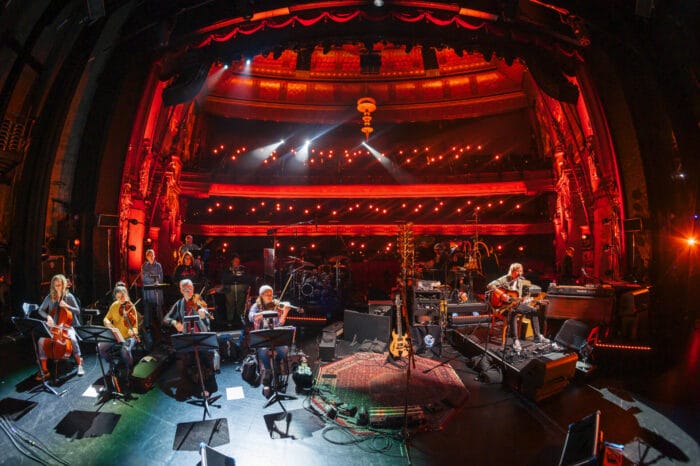
While you were experiencing all of this in the moment, was there a song that revealed a new side of itself or an unforeseen nuance?
One of them where I was losing my shit doesn’t have any words. It was “What’s the Use?” The title felt like something and I really liked what we all did with the song. Then the other one was “In Long Lines” because of the fact that it’s about dying and joining your ancestors and all that stuff. At the time, in this city with everything going on, it felt relevant in a way that it had never felt before.
There’s something else that’s tied in to all that. St. Vincent—Annie Clark—I watched her MasterClass on my app, and I thought she nailed this thing that I’ve never been able to verbalize. First off, she said, “Writing a song is like getting hit by a train.” When a song works, it’s not you. There’s a mystery to it. There’s a muse element. I know every musician has probably said some version of that. However, it’s what she added to it: “But you’ll never get hit by a train if you don’t spend a lot of time sitting on the train tracks.” I was like, “That’s it!” I love writing so much. I always have, going way, way back. If you look at a 1990 Phish show, we were fully formed with eons of deep stacks of original music.
I was writing in third grade, and COVID was just the same. I released so many songs on Instagram. Every two days I was putting out a new song. Some of them were just by me and some of them were co-written. I was just writing all the time, and even when I do collaborate, I usually do a lot of cutting and pasting and crafting in the aftermath. Then, once in a while, these things come out that have a hidden meaning you didn’t see.
I think Annie hit the nail on the head. It’s a mysterious thing that comes from somewhere we can’t explain, but you have to be open to it. The way to be open to it is to be continually working that muscle. Then, occasionally, something beyond you happens.
Do some of these songs also take on a different meaning? Absolutely. That’s also true as you get older. Beyond that, I have no clue whatsoever how this stuff resonates with another person. I mean, no inkling. It’s like stumbling along through the dark, banging your knee on the corner of the table.
Is there another moment of musical fortuity from the Beacon Jams that comes to mind?
I loved the “Stash.” It was just me, Jeff [Tanski] on piano, and I think Cyro [Baptista] was clapping. Cyro was going to play percussion instruments, but we just kept stripping it down.
I also enjoyed “Divided Sky,” which kind of highlighted the actual writing because Jeff reads a chart. He gets every single note. With Phish, we’ve veered off a little bit from the actual written music. All those songs originally were charts. They were completely composed. “Foam,” “Stash,” “Divided Sky” and “Petrichor,” all those songs are fully composed—bass, piano, everything.
Jeff went back to the original charts and then crafted them very accurately. He doesn’t make mistakes. [Laughs.] So I really liked that. Then we kind of took that on the road. Jeff just came out on my solo acoustic tour, and I loved what we were playing. I did solo acoustic, and then he would come out in the second half.
I can’t wait to do it again. I mean, for me, playing “Petrichor” with just Jeff on the piano and me on the acoustic guitar and nailing all the notes is such a deeply satisfying experience.
I think the breakthrough on that was probably “Stash.” I was like, “Jeff, let’s just do it, me and you.” That was because of the fact that it wasn’t a concert.
I also really liked the week we got into the Garden to recreate when I was stuck on the platform [for the “43 Weeks Later” video, which was released on 10/30/20, at the outset of the fourth week’s stream].
It was unbelievable that we managed to pull that one off. We just called over and asked, “Hey, can we get the key?” They said, “Sure.” Then we were like, “Wait, how do we get the key?” And they told us: “We’ll leave it under the mat.” It was kind of like that. [Laughs.]
So I got the key to Madison Square Garden, went in and it was completely empty. I think there were only three people there. It was so weird.
Then we printed up all those newspapers with fake articles, and that all happened within the space of one week.
We also did this thing with Don Hart and a string quartet. I don’t know if anybody noticed this detail. When I was stuck on the platform for real, I made up a song on the spot. That’s when I came up with the term “Rescue Squad.” I was stranded on the platform, and I spontaneously sang, “It’s time to leave/ It’s 2020 now/ It’s a whole new year/ And someone’s coming to rescue me/ At least, I hope so/ Goodbye, 2019/ Let’s give a big hand for the Rescue Squad.” That’s when they rescued me.
I called them the Rescue Squad and basically, two months later, it was the pandemic. Then, when we started the Beacon Jams, we put together the string section, and we ended up calling them the Rescue Squad.
When we made “43 Weeks Later,” we started at the platform. I’m still up there and my hair is really long because I never made it down. So for the opening montage, I called Don Hart, who’s my string arranging friend, and I was like, “Can you take my song from the platform and make a baroque string arrangement of it?” [Laughs.]
Then it opened with this really sad COVID string quartet version of the song I sang on the platform, note for note. I don’t know if anyone noticed that, but it’s so good. We had it written, arranged and recorded in like a day. It was some BoJack level detailing.
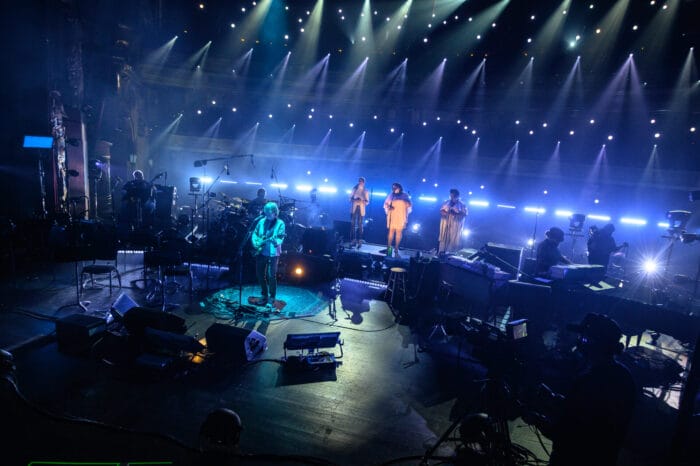
Given the positive nature of the whole Beacon Jams experience, did you ever contemplate sneaking in a week nine encore?
If I did that, I don’t know if I could have stopped. [Laughs.] If I had my way, I would just do that. It fits my personality perfectly. It’s like Saturday Night Live style. You get up in the morning and you’ve got a week to put together a show.
We put that whole film together inside of one week, including making those fake newspapers and the Spatchcocking magazine with me on the cover where it says, “You can spatchcock anything.” We also did one with Tom Brady that we threw in a puddle and I stepped on because I’m a Jets fan. [Laughs.] We were laughing on the phone coming up with all these headlines, then we had to design them and print them. So we were calling around looking for somebody who could do that and FedEx them to us.
The idea behind the whole thing was that I woke up on the platform and nobody had ever rescued me, so the pandemic happened without me knowing it. I was like the guy in 28 Days Later, and we recreated it, shot for shot. Trey Kerr came into the Garden and he brought a teeny, little drone with a camera on it, along with a handheld camera. There were just a few of us in there. It was unbelievable.
So we created all these newspapers and there’s a music magazine I find when I’m walking up the escalator at the Garden that says, “Trey to Play at the Beacon,” although it’s all something of a dream.
Then we went to the Beacon. I sat down upstairs and we made a camera shot that went from the Trey on the balcony down to where I’m with the band playing on stage. When it went down to the band, we had to do this crossfade on the fly to the actual live band. That was badass, and Garry was hugely influential on that. It’s why Russ is wearing headphones. We were proud of that one. You had to start the video and then crossfade to live sonically, with no recognition whatsoever about what was happening. That would’ve been an incredible achievement even for a regular TV show, but it was done during COVID when nobody could do anything. You couldn’t move because of the COVID restrictions, so everything we did was hyper-difficult, which also made it very satisfying when it worked.
The Beacon Jams raised $1.2 million for the Divided Sky Foundation, which you’ve said was far more than you’d initially anticipated. Can you talk about how that altered your plans for what followed?
I think the original idea at the very outset was to create a generalized foundation. We were on the phone one day and somebody suggested we call it the Divided Sky Foundation, and I was like, “OK, why not?”
I’m sober and I’m kind of active in the sober community. One of the things that was happening during COVID is I was hearing about a lot of people at home drinking and drugging. You couldn’t go to in-person meetings anymore and the numbers in Vermont went way up.
Then we had the fentanyl thing going. It was like the backside of the opiate crisis was still in full swing. So there were opiate overdoses and people also were sitting in the living room and drinking. I was hearing about all that.
That’s when the idea came together that maybe we could do something.
Our initial goal for the Beacon Jams was to connect people with some kind of music. The next idea was to make it free. From there, the thought was that as a community, we could circle the wagons during the eight weeks and raise some money. So the conversation was about turning this positive into a double-layered positive.
Then it all happened kind of fast. At the beginning, I didn’t know it was going to be a physical space, but Melanie Gulde and I began talking. Melanie is the clinical director up there. She was my case manager when I was in drug court, and after that, we became very good friends.
For 14 months, she was my case manager when I got sober, which was 18 ½ years ago. We’ve gone to Washington, D.C. together to speak in support of a nationalized drug-court program, and we’ve been active together as friends trying to do something positive for people with drinking and drug problems.
At the outset of the Beacon Jams, the money raised by the Foundation was going to be reserved for putting some kind of positive back in that world. We didn’t have specific plans at first, but it quickly became us saying, “Let’s open a facility because Vermont is underserved.”
Ludlow was the epicenter of Vermont’s opiate overdose deaths at the time. That was right where the worst kind of rural opiate crisis was hitting. So it all kind of fell into place.
There was a moment of need and it came together quickly. We raised the money— everybody just kind of stepped up—and we purchased the site. Then there were a lot of legal hurdles and permitting issues. We also had to modify the building, but the long and short of it is that it worked in what now seems like the blink of an eye. It’s only five years later and the place is thriving. Everybody’s just awe of what’s happening here because it’s a really great program. It’s already blossoming. The whole thing is just unbelievable.
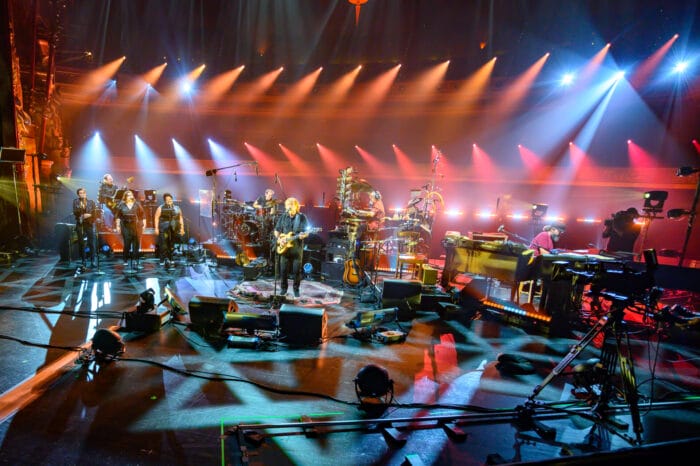
As you’ve been thinking ahead to this November’s Beacon Jams, is there something that you didn’t get to try the first time around or has since occurred to you, that you’d like to implement?
First of all, I really liked the way the Beacon Jams was so flexible that I could go to “Sunset Days” on the acoustic guitar, then Jeff and I would play “Stash” with Cyro clapping. Then we’d have an eight-piece string section, a three-piece horn section, percussion, drums—all fluidly. I kept thinking it was like the show that Johnny Cash used to have. They don’t have those anymore, but that’s what it felt like at the time—“OK, now we’re going to turn around and face the other direction.”
Some bands I love, like the Yeah Yeah Yeahs, manage to combine a rocking song and an acoustic song—they’re great musicians. If you think about it, Taylor played solo acoustic on the Eras Tour in front of 80,000 people, so it’s possible.
It’ll be interesting, thrilling and scary trying to figure out how to balance this, especially at the Beacon facing forward, because the Beacon has seats, yet our crowd tends to stand up and dance. I want to do both, and I don’t think I’m going to know until I get there exactly how to fulfill all those needs.
Like I said, two of the songs that I really liked are “What’s the Use?” which is so intense and “In Long Lines” from the Ghosts night. Both of them are perfectly doable.
Beyond that, I’m still writing a lot of new music. As time goes on, there’s a question about the introduction of new music, such as “What’s Going Through Your Mind,” which was written after our last album and is now in the world of Phish. It didn’t make it on an album, and I’m kind of like, “Well, that’s too bad. It would’ve been good.”
So that’s always interesting because we have so many songs that people want to hear, and I think the blessing from where I stand, is that there’s no shortage of good new material. Thank God I’m still writing new material, but since I do have new material, does that become part of it? Do I continue to go forward? I mean, I’d like to continue to go forward, so I don’t know.
Something else I want to keep in mind is that two members of the band died between the Beacon Jams. Neither of those band members can be replaced in any way, shape or form. I mean, for me, they’re absolute pillars—Tony and James are towering figures in my life of music that I got to collaborate with. I’ll never forget them and they’re there with us. Now, we have Kenneth [Whalum] and Dezron [Douglas]. They’re not the same, but they’re equally staggering talents.
During COVID, Phish had its weekly Dinner and a Movie archival video series, which launched a few months prior to the Beacon Jams. At the time, you mentioned that you had never really seen Phish before. To what extent have you gone back and watched the Beacon Jams?
I’ve seen a little bit but not a whole one. I did go back a little, but this is probably true with a lot of musicians: There is a difficulty in not wanting to edit when you’re watching yourself. I’ve seen some of the stuff from the Beacon Jams—just a few songs—and for the most part, it makes me feel a lot of joy and pride. I feel incredibly grateful that I was part of that experience and shared it with so many people.
I still get stopped on the street by people who talk to me about how much it meant to them at that time, and nothing could be more meaningful to me. Again, it was the idea that we shared this with people at home, it was free and we created a community out of thin air when community was hard to find. Like I said, there weren’t any AA meetings, except for online, and there weren’t any concerts, but we were able to fund the creation of a sober retreat up in Vermont while sharing a musical retreat. It’s just crazy it all happened that way. I’m so grateful for it.
I can’t wait to celebrate it after five years. It’ll be incredibly emotional to be back in that space of the Beacon Jams, but to have everybody in the room with us. It was empty and now it’s not. So hallelujah!

